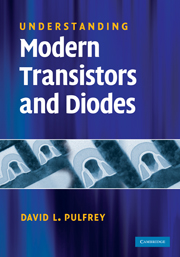Book contents
- Frontmatter
- Contents
- Preface
- 1 Introduction
- 2 Energy band basics
- 3 Electron and hole concentrations
- 4 Thermal equilibrium
- 5 Charge transport
- 6 np- and Np-junction basics
- 7 Solar cells
- 8 Light-emitting diodes
- 9 HBT basics
- 10 MOSFET basics
- 11 HJFET basics
- 12 Transistor capacitances
- 13 Transistors for high-speed logic
- 14 Transistors for high frequencies
- 15 Transistors for memories
- 16 Transistors for high power
- 17 Transistors for low noise
- 18 Transistors for the future
- Appendices
- Index
6 - np- and Np-junction basics
Published online by Cambridge University Press: 05 June 2012
- Frontmatter
- Contents
- Preface
- 1 Introduction
- 2 Energy band basics
- 3 Electron and hole concentrations
- 4 Thermal equilibrium
- 5 Charge transport
- 6 np- and Np-junction basics
- 7 Solar cells
- 8 Light-emitting diodes
- 9 HBT basics
- 10 MOSFET basics
- 11 HJFET basics
- 12 Transistor capacitances
- 13 Transistors for high-speed logic
- 14 Transistors for high frequencies
- 15 Transistors for memories
- 16 Transistors for high power
- 17 Transistors for low noise
- 18 Transistors for the future
- Appendices
- Index
Summary
When neighbouring regions of a homogeneous semiconductor are doped with different types of dopant, a pn- or np-junction is formed. When the junction is between different semiconductors, the junction is labelled either Pn or Np, where the capital letter denotes the doping type of the semiconductor with the higher bandgap. Semiconductor/semiconductor junctions play a crucial role in solar cells, LEDs, bipolar transistors, and HJFETs, and are prominent also in MOSFETs. As we demonstrate in this chapter, a potential energy barrier forms at this type of junction. In a solar cell, this barrier facilitates the separation of photogenerated electron-hole pairs into a current. In the other devices, the modulation of the junction barrier height by an applied voltage allows the current to be controlled by external circuitry.
In this chapter the focus is mainly on the np-junction; it is used to achieve an understanding of the properties of semiconductor junctions via the drawing of an energy-band diagram, the construction of which is explained here. We also introduce the concepts of quasi-neutrality and quasi-Fermi levels. The latter prove useful in describing carrier concentrations under non-equilibrium conditions. Finally, the Np-junction is described, and some consequences of the bandgap mismatch are noted.
np-junction at equilibrium
To construct the equilibrium energy-band diagram for an np-junction, consider first Fig. 6.1a, in which the separate n- and p- type regions are shown.
- Type
- Chapter
- Information
- Understanding Modern Transistors and Diodes , pp. 91 - 115Publisher: Cambridge University PressPrint publication year: 2010



